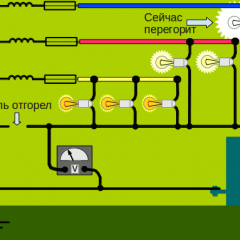What are the quality indicators of electricity
Review of key indicators
The quality of electricity is determined by the compliance of the parameters of the electric network, the established values of certain indicators. All parameters of electric energy most of the time in days (95%) should correspond to the normal set values and not exceed this limit.
GOST 32144-2013 divides indicators and quality standards into two categories: basic and additional. Basic determine the properties of electricity. This subgroup includes 9 voltage characteristics and 1 frequency characteristic. Consider a number of key indicators in more detail.
Voltage deviation. It has the greatest impact on consumer performance. Loads, voltage levels, and other parameters can change over time. Based on this, the value of the voltage drop is also variable. At the same time, a significant reduction in tension at industrial enterprises has a negative impact on overall labor productivity, and adversely affects the vision of workers. Also, voltage reduction affects the duration of most technological processes in electrothermal and electrolysis plants. In addition, the mismatch of the voltage level to the required values leads to a loss of voltage and power.
In networks up to 1 kV permissible voltage deviation ± 5%, maximum ± 10%. In networks of 6-20 kV, the maximum deviation is ± 10%.
The magnitude of the voltage change. This parameter of the quality of electricity represents the difference between the amplitude or current value before and after its change. The repetition rate of these changes can be from 2 times / min. up to 1 time / h. Such abrupt changes in a three-phase network can be caused, for example, by the operation of an arc steelmaking furnace or a welding machine. The regulation of voltage fluctuations is based on the need to protect people's eyesight. Each type of lamp has its own separate span value. To ensure compliance with this quality indicator, it is recommended to use a separate power supply for power consumers of the lighting network and power loads.
Voltage fluctuation dose, which is an analogue of the previous indicator of the quality of electric energy, they are interchangeable. Rationing of the dose of oscillations in electric networks is carried out only if certain devices are available in them.
Voltage dip duration. Failure is a sharp decrease in voltage, after which it is restored back to its original or approximate value after a certain time period. The duration of the failure reflects the time from the initial moment of failure to the moment of its recovery. The duration of the failure can be both in one period and in tens of seconds. According to GOST, this parameter can reach 30 seconds in networks of up to 20,000 volts.
Impulse voltage the failure is similar in description, but its duration is different, and ranges from a few microseconds to ten milliseconds. Permissible values of this indicator of the quality of electricity are not standardized by the standard.
The voltage characteristics are also four coefficients: harmonic component, non-sinusoidality of the curve, zero and negative sequence.
A characteristic of the frequency is the deviation. The greatest frequency deviation occurs if the loads change at a slow pace and the power reserve is small. The normal permissible deviation is ± 0.2 Hertz, maximum ± 0.4 Hertz. In post-accident conditions, the deviation interval from + 0.5 to - 1 Hertz is permissible (no more than ninety hours a year).
Additional indicators of the quality of electricity are the main form of recording. This includes the following 3 coefficients characterizing the voltage: amplitude modulation, as well as unbalance of phase and interphase voltages.
Measurement methods
There are three main types of devices with which you can measure indicators:
- measuring - represent clamp meterhaving an indication unit; determine only the nominal values of the parameters, are used for daily monitoring;
- analyzing - in addition to determining the nominal parameters, they are able to analyze phase imbalance, losses, are able to assess energy losses; used for single measurements;
- recording - are stationary devices, perform the same functions as analyzing devices, but for a long time; they allow you to build any necessary graphics.
To ensure the reliability of the functioning of power systems, it is necessary to comply with the quality indicators of electric power to specific requirements. To do this, they are standardized. In order to timely monitor compliance of parameters with regulatory values, monitoring is necessary. Quality control is carried out by the working personnel of energy enterprises.
The duration of measuring each indicator is at least twenty-four hours, while the frequency of control is established by the international state standard and is 1 time in two years, except for voltage deviation (2 times a year).
In more detail this question is considered on video:
So we examined the main indicators of the quality of electricity, their rationing and measurement methods. We hope the information provided was interesting and informative for you!
It will be useful to read:










One comment